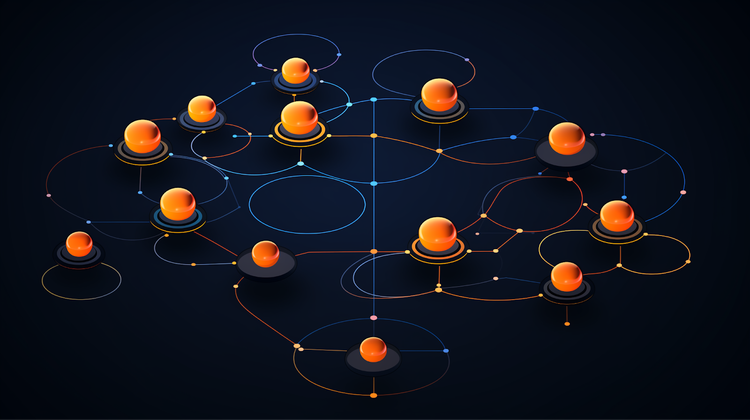Holacracy
Transforming Organizational Freedom at Groundfog
Explore the concept of Holacracy that is transforming the organizational dynamics of Groundfog. Discover the simplicity in complexity, the role-centered hierarchy and the power shift that empowers the individual. Experience the effectiveness of this decentralized approach in practice and learn valuable lessons from Groundfog's journey. Dive deeper into the world of Holacracy with Groundfog's article embracing a more agile way of working.
What is Holacracy?
Have you ever wondered how a company can thrive without a traditional hierarchy? It may seem exotic, even bewildering, in the world of business. In this article, we'll take you on a journey through our firsthand experience with a decentralized organizational system, known as Holacracy, and explain how it has completely changed the way we work.

We have encountered several definitions that describe Holacracy, so we will steer away from creating another one. Instead, let us look at the main pillars that Holacracy is built on and what appealed to us.
When you first come into contact with it, either by practicing, as we did, or by reading, it seems to be a complex system. It’s like a game you want to learn, and that makes you give up before even trying. When you get past this “organizational block”, think of a “writer’s block,” where a blank page is the biggest obstacle. A world of opportunities unfolds.
Simplicity in Complexity: The Core Principles of Holacracy
The core rules, processes, and structure of a holacratic organization are documented in the Holacracy Constitution. You might now think, ‘That’s the opposite of simple!’. Let’s pause and #rethink for a second. The FIFA rulebook is almost 200 pages long. Does this stop people around the world from playing football with their friends on the weekend? The answer you have just given yourself applies. In 99% of the cases of Holacracy too. It is something you learn by doing. The constitution coined an important idea: the authority in an organization is redistributed. But it is not just about reshuffling power from leaders to someone else. It is rather a shift from a person at the top to a role or a process.
Role-Centric Hierarchy: The Heart of Holacracy
At first glance, Holacracy seems to be “flat” or “disorganized” when it’s the opposite. It is actually a very structured way to enable distributed authority and self-organization, with lean but effective guardrails and processes. How does it achieve this? By moving away from a hierarchy of people to a hierarchy of roles, please notice the subtlety that often goes unnoticed – there is a hierarchy.
In the words of Steve Jobs, 'It doesn't make sense to hire smart people and then tell them what to do; we hire smart people so they can tell us what to do.' This quote beautifully captures the spirit of Holacracy – the decentralization of decision-making and the empowerment of individuals to take ownership of their work and responsibilities, a core principle of our holacratic approach. Now you are probably keen to learn how this hierarchy looks in practice. It starts with a simple shape. It’s no longer a monolith (the old, familiar pyramid), but it looks rather like a living organism (it has cells).
Roles and Circles: The Building Blocks of Holacracy
Well, there are not actually cells; we call them roles. A role is like a mini-job description with a purpose and clear accountabilities. Another key difference between holacratic and traditional organizations is the relationship between people and roles, which is one-to-many. Someone in a holacratic organization may energize multiple roles, and a role can also have several role fillers. What we like about this structure is that it makes expectations very clear, offers transparency into what others are doing, and creates a structure where people can safely experiment with new tasks and fields of interest.
You can guess what happens next, right? By interacting more on a skill and interest level, innovation and idea generation happen more often and in a more natural way. It’s like having smaller-sized brainstorms on a regular basis.

Circles
Now let’s assume that we have many role fillers, and the roles grow in complexity. Just like a cell, it divides and creates a more complex structure. In this case, it becomes what we call a „circle." Circles are home for a certain topic, which can range from finance, a project, or the group that organizes events in the local office. Just like the role, it is characterized by a purpose, clear accountabilities, and a strategy.
Notice one big little element that is always there: purpose. Being purpose-driven doesn’t only keep everyone rowing in the same direction with meaning, but it also avoids complicated structures. If the purpose is not clear, then probably that role or circle is too complex to exist in the first place.

Holacracy in Action
We now have a snapshot of the structure - we have roles grouped in sub-circles which make larger circles. What makes the work more effective in this setup? For us, there are two big aspects:
Getting Work Done
A single person no longer holds the “power” in Holacracy, and every individual is encouraged to take initiative and “lead” their own roles. This means taking the best actions to fulfill the purpose. Processing the operational, daily work translates into tensions. The term may have a negative connotation, but in Holacracy, it literally means everything. From facing an issue you can’t get done alone to sharing information or requesting an opinion. Getting work done (aka. processing the tensions) requires a collaboration vehicle, which was traditionally a meeting. This concept hasn’t been reinvented by Holacracy, but it has been masterfully streamlined.

Organizational Evolution
So now we have a simple engine that runs smoothly. What if we want to upgrade some parts and make them better? In Holacracy, there is no single mechanic but several ones. Since every circle member senses tensions from their roles, more contact points with input are available than having only a boss dealing with the strategy and what needs to be done.
Holacracy's governance meetings provide a structured way to change the organization. Is a new role needed? Create a governance proposal. Is a circle no longer relevant? Remove it via governance. Is a role doing something that is not captured in the accountabilities? Add it via governance. The beautiful part is that everyone can make proposals. It’s no longer the management’s sole duty. An additional advantage is that governance proposals can be addressed offline, saving teams valuable time that would otherwise be spent in meetings.
Here is where the concept of objections comes into play. While everyone’s opinion is heard and embraced, it doesn’t mean it automatically gets accepted. Whenever a proposal is objected to by a circle member, it undergoes a rigorous validation process. Not everything that sounds good the first time is actually a valid objection, so don’t worry; creating chaos is not that easy.
Our Holacracy Journey: Lessons from Experience
Just like football is not a game for everyone, Holacracy is not a framework for every organization. For us, Holaracy is not just an abstract idea; it's the very fabric of our work lives. Our journey through this unusual but amazingly effective organizational model has been a rewarding experience. One in which we've discovered that using a decentralized structure allows us to be more responsive to change, encourage diversity, and simply represent our core principles. It is a transition that keeps us connected, adaptable, and dynamic, especially in today's ever-changing tech world.
It is not an experiment at Groundfog; it is our daily reality. But our story does not end here. If you're eager to discover more about our journey and the particular culture that defines Groundfog, we invite you to check out our website.
Here, you can learn more about how Groundfog operates, is driven by our core values, and what sets us apart as a company. Keep an eye out for our upcoming article, where we'll dive even deeper into the fascinating world of Holacracy. Your journey into a more agile way of working begins here.
Start your career at Groundfog
Ready to take the next step in your career and join a team that values your contributions and growth? Submit your resume and share your feedback with us through the form below, and let's make it happen!

